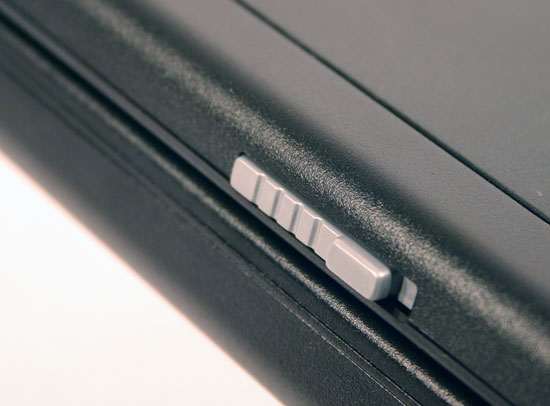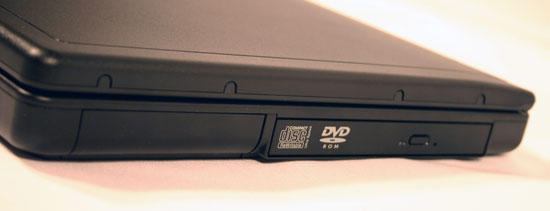$600 Notebook Roundup - Crowning the Affordability King
by Anand Lal Shimpi on November 29, 2005 10:38 AM EST- Posted in
- Laptops
Dell Inspiron 2200
Since originally ordering and receiving the Dell Inspiron 2200, Dell has introduced a new line of Inspiron notebooks for the home. The Inspiron B130 is Dell's latest competitor in the sub-$600 market; however, its release was not in time to be included in this roundup. We chose to keep the Inspiron 2200 in this review as it is still available for Higher Education customers, but we will be working to bring an updated roundup with the Inspiron B130 as soon as possible.
The Inspiron 2200 that we received came with a Celeron M 370 (1.5GHz) processor based around Intel's 915GM chipset; naturally, it uses the chipset's integrated graphics. The Inspiron B130, the 2200's replacement, moves back down to a Celeron 360 (1.4GHz) as its default processor option.
Like all of the notebooks here today, the Inspiron 2200 that we configured only shipped with 256MB of RAM, to keep within our $600 budget. Storage comes courtesy of a single 40GB Fujitsu MHV2040AH drive.
Unfortunately, in order to meet the $600 budget, the Inspiron 2200 comes with no wireless networking options.
Surprisingly enough, there are no ports at the front of the notebook:
- Headphone jack
- Microphone jack
- PC Card slot
- 3 USB 2.0 Ports
- Ethernet jack
- Modem jack
- VGA output
Since originally ordering and receiving the Dell Inspiron 2200, Dell has introduced a new line of Inspiron notebooks for the home. The Inspiron B130 is Dell's latest competitor in the sub-$600 market; however, its release was not in time to be included in this roundup. We chose to keep the Inspiron 2200 in this review as it is still available for Higher Education customers, but we will be working to bring an updated roundup with the Inspiron B130 as soon as possible.
The Inspiron 2200 that we received came with a Celeron M 370 (1.5GHz) processor based around Intel's 915GM chipset; naturally, it uses the chipset's integrated graphics. The Inspiron B130, the 2200's replacement, moves back down to a Celeron 360 (1.4GHz) as its default processor option.
Like all of the notebooks here today, the Inspiron 2200 that we configured only shipped with 256MB of RAM, to keep within our $600 budget. Storage comes courtesy of a single 40GB Fujitsu MHV2040AH drive.
Unfortunately, in order to meet the $600 budget, the Inspiron 2200 comes with no wireless networking options.
| Dell Inspiron 2200 | |
| CPU | Intel Celeron M 370 (1.5GHz/1MB L2/400MHz FSB) |
| Chipset | Intel 915GM |
| Memory | 256MB DDR333 (1 DIMM) |
| GPU | Integrated Intel Extreme Graphics |
| Display | 14.1" XGA (1024 x 768) |
| HDD | 40GB Fujitsu MHV2040AH |
| Optical Storage | 24X CD-RW/DVD-ROM Drive |
| Wireless | N/A |
| Ethernet | Intel PRO/100 VE 10/100 |
| Modem | Internal Soft 56K |
| Audio | SigmaTel C-Major |
| Ports | Headphone, microphone, PC Card slot, 3 x USB 2.0, Ethernet, Modem, VGA out |
| Mouse | Trackpad |
| Size (L x W x H) | 13.0" x 10.6" x 1.46" |
| Weight | 5.99 lbs |
| Battery | 8-Cell NiMH |
| OS and Other Software | Windows XP Home SP2 |
| Price as Configured | $599.00 |
| Warranty | 90 days |
Surprisingly enough, there are no ports at the front of the notebook:


- Headphone jack
- Microphone jack
- PC Card slot

- 3 USB 2.0 Ports
- Ethernet jack
- Modem jack
- VGA output











50 Comments
View All Comments
Hacp - Tuesday, November 29, 2005 - link
x200 graphics with/o dedicated memory.If you get x300 graphics with some dedicated memory, it should play some of hte latest games at halfway acceptable settings. Just dont' expect to be playing FPS smoothly though, but RPGs/rts should be fine. Racing should be fine too.
manno - Tuesday, November 29, 2005 - link
meLoneWolf15 - Tuesday, November 29, 2005 - link
Interesting to note that even without Speedstep, the Celeron-M still has better battery life. Then again, didn't Intel change some designs in transistor-switching to make battery performance better even at full speed?One comment, more to notebook manufacturers: Where the heck is my Trackpoint mouse? I can't stand touchpads, which require me to take my fingers off the keyboard to use, when a trackpoint can be used almost simultaneously. I can type 75-80wpm, and don't find touchpads very efficient for this reason (my older but top-of-the-line-when-released Latitude C840 has both devices). Somebody, please bring back the Trackpoint!
Hacp - Tuesday, November 29, 2005 - link
Also, why do you have to take your fingers of the keyboard to use the touchpad? I keep one hand on the keyboard, and one hand on the touchpad when using my computer. Rightclick is tap top right corner, leftclick is tap anywhere on the touchpad that doesn't involve the top right corner.Zorba - Tuesday, November 29, 2005 - link
I too hate touchpads and miss the old mouse sticks. I always rub the touchpad with my arm when typing and usually end up clicking some where I don't want to. It also takes me much longer to navigate with a touchpad and I usually accidently click something because I change the amount of pressure on the pad (I know you can turn the clicking off, but I still don't like the pad). It is a personal preference but I would like to at least be given the chance to pick between the two.matthewfoley - Tuesday, November 29, 2005 - link
Yeah, well I hate the mouse sticks. Who cares.Zorba - Tuesday, November 29, 2005 - link
The point the original poster and I were trying to make is manufacturers should include both devices, which a lot of them used to do.Hacp - Tuesday, November 29, 2005 - link
The battery life difference is most likely due to the ATI chipset and integrated graphics, which uses more power than intel EE.Tamale - Tuesday, November 29, 2005 - link
page 9's link to page 10 is shotTamale - Tuesday, November 29, 2005 - link
nvm :]